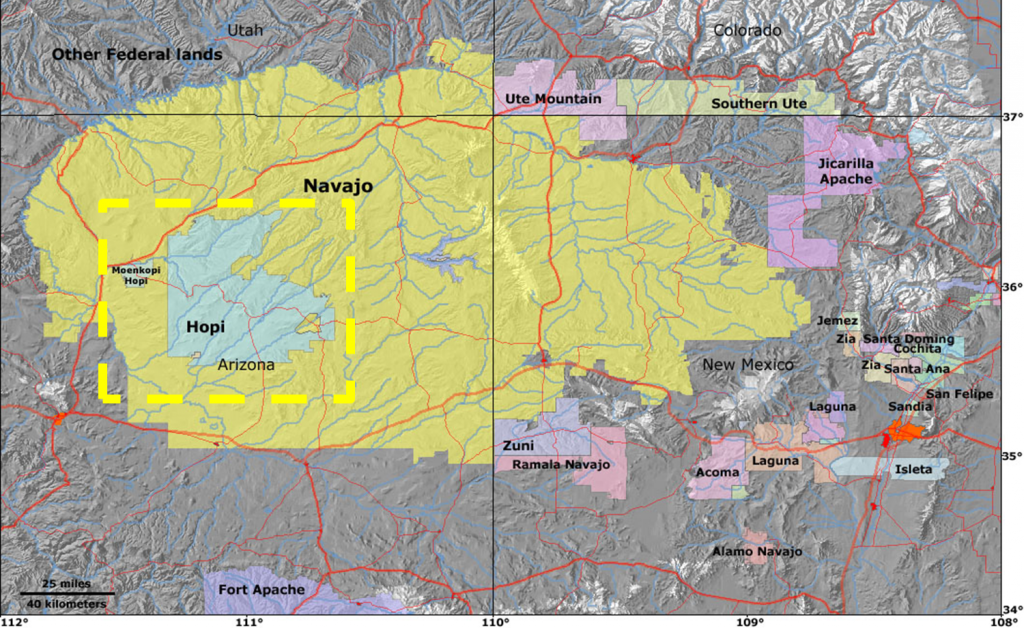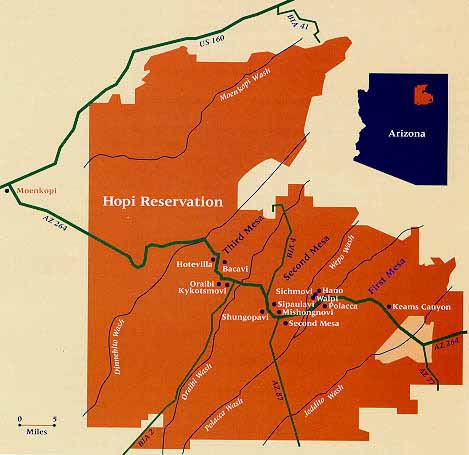Reservation
In 1882, an executive order from President Chester A. Arthur established the Hopi Reservation.[1] The reservation is in northeastern Arizona, in Coconino and Navajo Counties, and consists of over 1.5 million acres.[2][3]
Population
The 2010 Census reports 18,327 Hopi living within the United States.[4] However, there are fewer than 7,000 residents on the reservation.[5]
Settlement
In 2012, a settlement agreement pertaining to Little Colorado River rights was proposed and initially accepted by the Hopi.[6] The Act, put forth by Arizona Senators McCain and Kyl, “would require the tribes to waive their water rights for ‘time immemorial’ in exchange for groundwater delivery projects.”[7] The Act would have settled the unsettled claims between the Navajo and Hopi regarding the Little Colorado River.[8] In December of 2012, the Hopi retracted their support for the Act.[9] The Tribe also has contracted for water rights in Contract No. 04-XXX-30-W0432.[10]
Quantity
The Hopi are entitled to divert 6,028 afa per Contract No. 04-XXX-30-W0432.[11]
Source of Water
The Colorado River in Cibola, Arizona, is the diversion point for the contracted rights.[12] Additionally, natural springs and aquifers provide drinking water to the Hopi Reservation, although the quality and quantity of the water from these sources is diminishing to the extent that the water from some sources is unfit for consumption.[13] Several Hopi residences on the reservation have no immediate water source and are forced to rely on “village pumps or water houses.”[14]
Use
The Hopi Tribe uses water for religious ceremonies, agriculture, and domestic uses.[15] The Act would have prohibited marketing of Hopi water rights off-reservation.[16] The Tribe receives royalties for water leased to the Peabody Coal Company for mining activities on Black Mesa.[17]
Interview with Lionel Puhuyesva, Director of the Hopi Water Resources Program (November 11, 2012)
Lionel Puhuyesva is the director of the Hopi Tribe’s Water Resources Program. Mr. Puhuyesva explains that, until recently, the Tribe was entirely dependent upon precipitation for their traditional dry-farming. After nearly twenty years of drought, farmers are using well water for crops. The Tribe relies on groundwater resources for ceremonial use and domestic drinking water[18] and is reliant on the N aquifer.
Ideally, the Tribe could access Colorado River water to supplement their groundwater resources. Mr. Puhuyesva explains that the Tribe’s biggest challenge has been dealing with the Navajo Nation. As an entirely “landlocked” nation, the Tribe has struggled to work with the Navajo Nation. Both tribes draw on the N aquifer but the Hopi Tribe relies on the aquifer almost exclusively. There are serious concerns about the drawdown of this aquifer.
Protecting water quality as well as quantity is a primary concern for Hopi Water Resources. “Our main goal is just to get water here, to find another source of water. We need surety. Our recharge is uncertain and dependent on the Navajo Nation- we need another source of water.” Arsenic contamination is another challenge. “Because of this reliance”, Puhuyesva explains, “protection of groundwater is our primary concern. That is why we created an ordinance to enforce our water code. We needed to have a way to address the contamination.”
In addition to maintaining the Tribe’s water resources for consumptive uses, the Tribe relies on water resources for non-consumptive religious and cultural uses. Puhuyesva explains that “Many of the springs out here are culturally significant. People tend to want to protect certain springs and sites. Certain areas are tied to cultural traditions. We want to protect certain animals, plants, and wildlife.”
In terms of developing water resources for the future, “Our overall goal is primacy. Having more control over our water.” The Tribe is mainly concerned about developing a domestic means to deliver surface waters to households. Part of this plan involves obtaining a right of way for the pipeline to carry water across the Navajo Nation to the Hopi Reservation.
In addition to domestic supply, the Tribe “would like to find some way to use our water for agriculture.” Puhuyesva explains that “Farming has been a staple of our culture. But because of the prolonged drought, the people have not been able to farm as they once have. Just because our tribe hasn’t been known for irrigation doesn’t mean that it can’t be.”
Contact:
P.O. Box 123
Kykotsmovi, AZ 86039
Phone: (928) 734-3100
Fax: (928) 734-6665
If you would like to learn more about the this tribe, click here to go to their website.
[1] Hopi: The Real Thing, Four Corners Postcard, www.ausbcomp.com/redman/hopi.htm.
[2] The Hopi Tribe, www.Hopi-nsn.gov (last visited Apr. 8, 2013). Lionel P estimates that the reservation is actually closer to 1.9 million acres when you include the additional lands, which the Tribe has been acquiring near Holbrook, Arizona. Interview with Lionel P of Hopi, 11/7/2012
[3] The Reservation is entirely surrounded by the Navajo Reservation, which is telling of the contentious history that exists between the Reservations regarding property rights. (See also The Navajo-Hopi Land Issue: A Chronology, Hopi Cultural Preservation Office, http://web.archive.org/web/20080530212923/http://www.nau.edu/~hcpo-p/current/Chronology.html; Navajo and Hopi Settlement Act, Pub. Law No. 93-531, available at http://www.onhir.gov/N-H_Settlement_Act_-_titled.pdf.) President Arthur’s 1882 Executive Order diminished the Hopi Reservation by over one million acres, signing over much of their traditional land to the Navajos. (Hopi Reservation, Arizona State University, History, Nature, Culture and History at the Grand Canyon, http://grandcanyonhistory.clas.asu.edu/sites_adjacentlands_hopireservation.html.) The 1974 Navajo-Hopi Land Settlement Act made leasing and partitioning of the Reservation possible. (Deborah Lacerenza, An Historical Overview of the Navajo Relocation, Cultural Survival (Feb. 24, 2010), http://www.culturalsurvival.org/publications/cultural-survival-quarterly/united-states/historical-overview-navajo-relocation.)
[4] The American Indian and Alaska Native Population: 2010, 2010 Census Briefs, available at http://www.census.gov/prod/cen2010/briefs/c2010br-10.pdf.
[5] Arizona American Indian (AI) Reservation Acreage and Population: 1990 and 2000, available at http://apps.publichealth.arizona.edu/DataLine/Tribal_Health/Documents/Tribal%20Hlth%20Pop%20Charac_Table1a.pdf.
[6] Navajo-Hopi Little Colorado River Water Rights Settlement Agreement (2012) available at http://nnwrc.org/wp-content/uploads/2012/04/NHLCRS-Settlement-Agreement_13098967_16-23.pdf.
[7] Leslie MacMillan, A Difficult Choice on Water, Green, A Blog About Energy and the Environment (Apr. 6, 2012, 3:39 PM), http://green.blogs.nytimes.com/2012/04/06/a-difficult-choice-on-water/.
[8] Shaun McKinnon, Navajo-Hopi Water Deal Collapses, Beyond the Mesas (July 25, 2012), http://beyondthemesas.com/category/hopi-and-navajo-sb-2109/.
[9] Hopi Withdraws Support of Water Rights Settlement, KTAR The Voice of Arizona (Dec. 28, 2012, 9:09 AM), http://www.ktar.com/?nid=22&sid=1598170.
[10] U.S. Department of the Interior Bureau of Reclamation, Appendix C9—Tribal Water Demand Scenario Classification, Colorado River Basin Water Supply and Demand Study 25 (May 2012), http://www.usbr.gov/lc/region/programs/crbstudy/finalreport/Technical%20Report%20C%20-%20Water%20Demand%20Assessment/TR-C_Appendix9_FINAL_Dec2012.pdf.
[11] Id. at 26.
[12] Supra note 9 at 25.
[13] Drawdown, Groundwater Mining on Black Mesa, Natural Resources Defense Council (Mar. 2006) http://www.nrdc.org/water/conservation/draw/chap1.asp.
[14] Id.
[15] Supra note 15.
[16] Supra note 6.
[17] Water is Life Peacemaking Project, http://www.navajopeacemakers.org/ (last visited May 20, 2013).
[18] Interview with Lionel Puhuyesva, Director of the Hopi Tribe’s Water Resources Program, (November 7, 2012).


